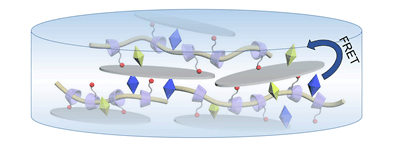| [1] Rao, K. V.; Datta, K. K. R.; Eswaramoorthy, M.; George, S. J. Adv. Mater. 2013, 25, 1713.
[2] Vijayakumar, C.; Praveen, V. K.; Ajayaghosh, A. Adv. Mater. 2009, 21, 2059.
[3] Zhao, Z. J.; Lam, J. W. Y.; Tang, B. Z. Soft Matter 2013, 9, 4564.
[4] Abbel, R.; van der Weegen, R.; Pisula, W.; Surin, M.; Leclere, P. Lazzaroni, R.; Meijer, E. W.; Schenning, A. P. H. J. Chem.-Eur. J. 2009, 15, 9737.
[5] Chen, Z.-L.; Li, H.-L.; Wei, J.; Xiao, Y.; Yu, H.-B. Chin. J. Org. Chem. 2015, 35, 789. (陈忠林, 李红玲, 韦驾, 肖义, 于海波, 有机化学, 2015, 35, 789.)
[6] Ikeda, M.; Yoshii, T.; Matsui, T.; Tanida, T.; Komatsu, H.; Hamachi, I. J. Am. Chem. Soc. 2011, 133, 1670.
[7] Cai, Z. Y.; Kwak, D. H.; Punihaole, D.; Hong, Z. M.; Velankar, S. S.; Liu, X. Y.; Asher, S. A. Angew. Chem., Int. Ed. 2015, 54, 13036.
[8] Ji, X. F.; Yao, Y.; Li, J. Y.; Yan, X. Z.; Huang, F. H. J. Am. Chem. Soc. 2013, 135, 74.
[9] Zhao, Q.; Chen, Y.; Li, S. H.; Liu, Y. Chem. Commun. 2018, 54, 200.
[10] Zhao, T.; Ding, H.-L.; Shi, G.-Y.; Jin, L.-T. Acta Chim. Sinica 2008, 66, 1209. (赵婷, 丁洪流, 施国跃, 金利通, 化学学报, 2008, 66, 1209.)
[11] Yu, G. C.; Yan, X. Z.; Han, C. Y.; Huang, F. H. Chem. Soc. Rev. 2013, 42, 6697.
[12] Tang, L.; Liu, W. G.; Liu, G. P. Adv. Mater. 2010, 22, 2652.
[13] Cordier, P.; Tournilhac, F.; Soulie-Ziakovic, C.; Leibler, L. Nature 2008, 451, 977.
[14] Dai, X. Y.; Zhang, Y. Y.; Gao, L. N.; Bai, T.; Wang, W.; Cui, Y. L.; Liu, W. G. Adv. Mater. 2015, 27, 3566.
[15] Wang, H. Y.; Heilshorn, S. C. Adv. Mater. 2015, 27, 3717.
[16] Nakahata, M.; Mori, S.; Takashima, Y.; Yamaguchi, H.; Harada, A. Chem 2016, 1, 766.
[17] Ji, X. F.; Shi, B. B.; Wang, H.; Xia, D. Y.; Jie, K. C.; Wu, Z. L.; Huang, F. H. Adv. Mater. 2015, 27, 8062.
[18] Sutar, P.; Suresh, V. M.; Maji, T. K. Chem. Commun. 2015, 51, 9876.
[19] Zhao, Q.; Chen, Y.; Liu, Y. Chin. Chem. Lett. 2018, 29, 84.
[20] Praveen, V. K.; Ranjith, C.; Armaroli, N. Angew. Chem., Int. Ed. 2014, 53, 365.
[21] Yang, H.-W.; Zhang, Y.-Z.; Li, Y.-J.; Wang, J.-X.; Li, X.-M.; Song, J.; Zhang, B.; Feng, Y.-Q. Chin. J. Org. Chem. 2017, 37, 1991. (杨贺玮, 张宇哲, 李艳杰, 王京翔, 李小萌, 宋健, 张宝, 冯亚青, 有机化学, 2017, 37, 1991.)
[22] Labanda, J.; Sabate, J.; Llorens, J. Colloids Surf., A 2007, 301, 8.
[23] Wang, Q. G.; Mynar, J. L.; Yoshida, M.; Lee, E.; Lee, M.; Okuro, K.; Kinbara, K. I.; Aida, T. Nature 2010, 463, 339.
[24] Li, Z. Q.; Zhang, Y. M.; Wang, H. Y.; Li, H. R.; Liu, Y. Macromolecules 2017, 50, 1141.
[25] Zhang, Y. M.; Zhang, X. J.; Xu, X. F.; Fu, X. N.; Hou, H. B.; Liu, Y. J. Phys. Chem. B 2016, 120, 3932.
[26] Khan, A. R.; Forgo, P.; Stine, K. J.; D'Souza, V. T. Chem. Rev. 1998, 98, 1977.
[27] Liu, G. X.; Zhang, Y. M.; Xu, X. F.; Zhang, L.; Liu, Y. Adv. Opt. Mater. 2017, 5, 1700149. |
